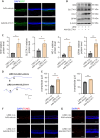Contribution of ferroptosis and SLC7A11 to light-induced photoreceptor degeneration
- PMID: 39104162
- PMCID: PMC12094538
- DOI: 10.4103/NRR.NRR-D-23-01741
Contribution of ferroptosis and SLC7A11 to light-induced photoreceptor degeneration
Abstract
JOURNAL/nrgr/04.03/01300535-202601000-00043/figure1/v/2025-06-09T151831Z/r/image-tiff Progressive photoreceptor cell death is one of the main pathological features of age-related macular degeneration and eventually leads to vision loss. Ferroptosis has been demonstrated to be associated with retinal degenerative diseases. However, the molecular mechanisms underlying ferroptosis and photoreceptor cell death in age-related macular degeneration remain largely unexplored. Bioinformatics and biochemical analyses in this study revealed xC - , solute carrier family 7 member 11-regulated ferroptosis as the predominant pathological process of photoreceptor cell degeneration in a light-induced dry age-related macular degeneration mouse model. This process involves the nuclear factor-erythroid factor 2-related factor 2-solute carrier family 7 member 11-glutathione peroxidase 4 signaling pathway, through which cystine depletion, iron ion accumulation, and enhanced lipid peroxidation ultimately lead to photoreceptor cell death and subsequent visual function impairment. We demonstrated that solute carrier family 7 member 11 overexpression blocked this process by inhibiting oxidative stress in vitro and in vivo . Conversely, solute carrier family 7 member 11 knockdown or the solute carrier family 7 member 11 inhibitor sulfasalazine and ferroptosis-inducing agent erastin aggravated H 2 O 2 -induced ferroptosis of 661W cells. These findings indicate solute carrier family 7 member 11 may be a potential therapeutic target for patients with retinal degenerative diseases including age-related macular degeneration.
Keywords: age-related macular degeneration; ferroptosis; light exposure damage; oxidative stress; pathway; photoreceptor; programmed cell death; solute carrier family 7 member 11 (SLC7A11).
Copyright © 2024 Neural Regeneration Research.
Conflict of interest statement
Figures







References
LinkOut - more resources
Full Text Sources

